Panasonic Lumix DMC-G1
-
-
Written by Gordon Laing
Panasonic Lumix DMC-G1 Studio resolution comparison
Panasonic Lumix DMC-G1 results continued…
| Support this site by shopping at Amazon | |||||||||||||||||||||||||||||||||||||||||||
 |
To measure and compare the Panasonic Lumix DMC-G1’s resolving power we photographed the Enhanced Digital Camera Resolution Chart with it and a number of rival cameras, each using their best quality JPEG and default image tone and sharpening settings. Each lens was tested at every aperture setting and the best result selected for this page. The crops are taken from the original images, saved as High Quality JPEGs in Photoshop CS2 and presented here at 100%. Each number represents 100 lines per picture height (lpph), so a figure of 20 means a resolution of 2000 lpph. |
In terms of resolving power, the Panasonic Lumix DMC-G1 and VARIO G 14-45mm kit lens at 25mm f8 delivers 2450 lpph of horizontal and vertical resolution. As you’d hope for a 12 Megapixel model, this is comfortably higher than the 2200 and 2150 lpph we measured for the 10 Megapixel Olympus E-3 and E-520 bodies respectively. It’s also a higher score than the 12.2 Megapixels of the Canon EOS 450D / XSi, although since each camera was capturing the same picture height, the Canon was effectively only using 10.8 of its Megapixels over the same area. Overall though a good result here for the G1 and its standard kit lens. Scroll down to the bottom of this page to see a RAW comparison, or head straight over to our Panasonic G1 High ISO results page to see how it measures-up across its sensitivity range. |
Panasonic Lumix DMC-G1 with G VARIO 14-45mm |
Olympus E-520 with Zuiko Digital 14-42mm ED | |
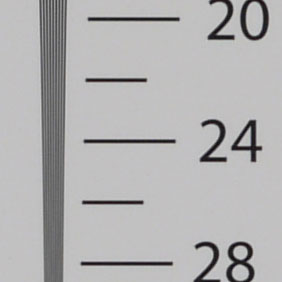 | 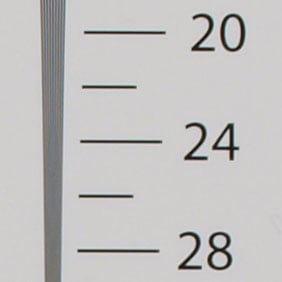 | |
2450 lpph, 14-45mm at 25mm, f8, 100 ISO |
2150 lpph, 14-42mm at 25mm, f8, 100 ISO | |
Canon PowerShot SX10 IS |
Canon EOS 450D / XSi with EF-S 18-55mm IS | |
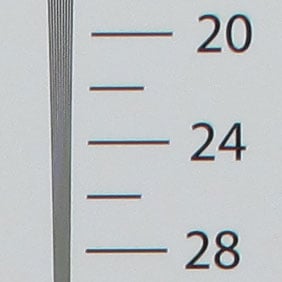 | 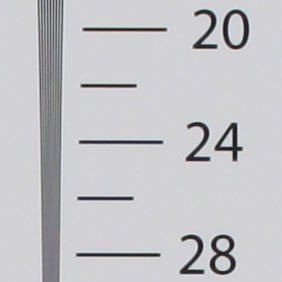 | |
2150 lpph, 5-100mm at 15mm, f4, 80 ISO |
2200 lpph, EF-S 18-55mm IS at 35mm, f8, 100 ISO |
Panasonic Lumix DMC-G1 with G VARIO 14-45mm |
Olympus E-520 with Zuiko Digital 14-42mm ED | |
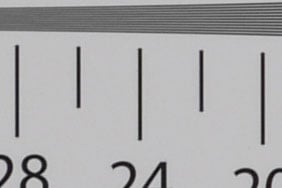 | 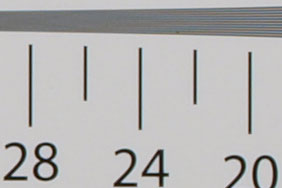 | |
2450 lpph, 14-45mm at 25mm, f8, 100 ISO |
2150 lpph, 14-42mm at 25mm, f8, 100 ISO | |
Canon PowerShot SX10 IS |
Canon EOS 450D / XSi with EF-S 18-55mm IS | |
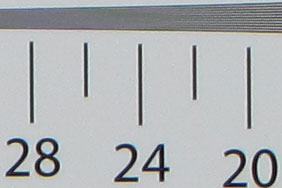 | 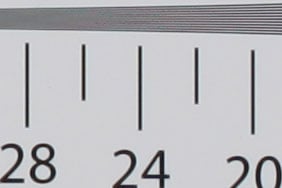 | |
2150 lpph, 5-100mm at 15mm, f4, 80 ISO |
2225 lpph, EF-S 18-55mm IS at 35mm, f8, 100 ISO |
Panasonic Lumix DMC-G1 Studio resolution: JPEG versus RAW
We photographed our test chart in the Lumix G1’s RAW plus Fine JPEG mode, allowing us to directly compare images created from exactly the same data. Below are 100% crops taken from the original JPEG file alongside the RAW version, processed using the supplied Silkypix Developer Studio 3.0SE software and its default settings.
The result here is similar to what we saw with a landscape subject on the previous page: more refrained processing on the part of Silkypix’s default settings has delivered an image which looks slightly softer and less punchy the in-camera JPEG.
Look closely though and there’s arguably a fraction more resolved detail – we’ve scored it as delivering 2475 lpph for both horizontal and vertical resolution. Now let’s check out the camera’s performance at different sensitivities in our Panasonic Lumix DMC-G1 noise results page.
Panasonic Lumix DMC-G1: JPEG with G VARIO 14-45mm |
Panasonic Lumix DMC-G1: RAW with G VARIO 14-45mm | |
 | 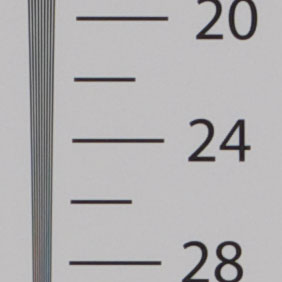 | |
2450 lpph, 14-45mm at 25mm, f8, 100 ISO |
2475 lpph, 14-45mm at 25mm, f8, 100 ISO |
Panasonic Lumix DMC-G1: JPEG with G VARIO 14-45mm |
Panasonic Lumix DMC-G1: RAW with G VARIO 14-45mm | |
 |  | |
2450 lpph, 14-45mm at 25mm, f8, 100 ISO |
2475 lpph, 14-45mm at 25mm, f8, 100 ISO |




